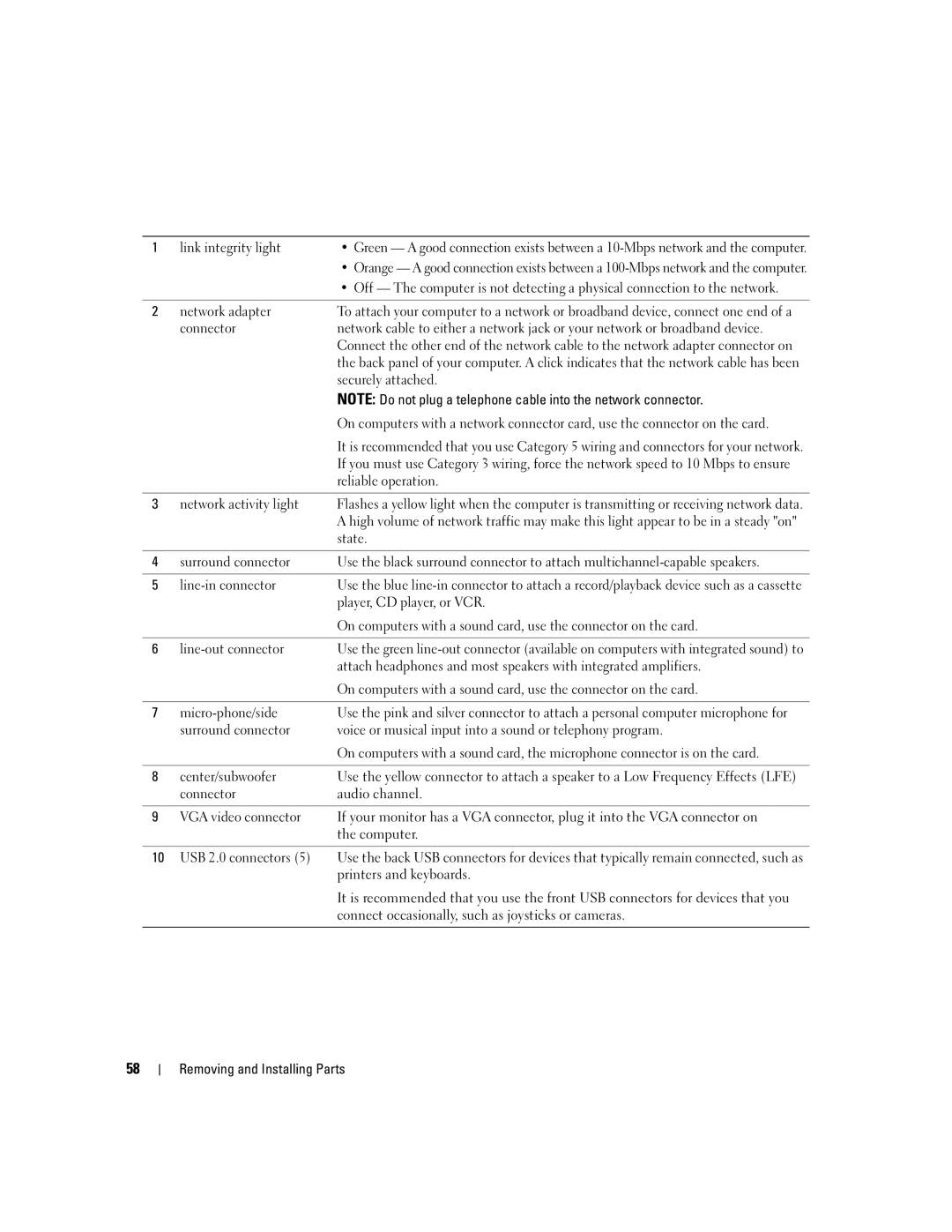W . d e l l . c o m s u p p o r t . d e l l . c o m
September T8144
Contents
Solving Problems
Mail, Modem, and Internet Problems
Resolving Software and Hardware Incompatibilities
Addressing Memory With 4-GB Configurations
Before Working Inside Your Computer
Connecting and Disconnecting Drive Cables
109
103
105
111
Contents
Finding Information
What Are You Looking For? Find It Here Warranty information
Finding Information
Microsoft Windows License Label
Use the Service Tag to
When you use
Identify your computer
Setting Up and Using Your Computer
Setting Up a Printer
Printer Cable
Connecting a Printer
Connecting to the Internet
USB connector on computer USB printer cable
Setting Up Your Internet Connection
Next window, click the appropriate option
Playing CDs and DVDs
Adjusting the Picture
Adjusting the Volume
DVD player includes the following basic buttons
How to Copy a CD or DVD
Copying CDs and DVDs
Helpful Tips
Using Blank CDs and DVDs
Media Type Read Write Rewritable
Using a Media Card Reader Optional
II CF I/II
Connecting Two Monitors
XD-Picture Card
MicroDrive Card
Follow the procedures in Before You Begin on
Connecting Two Monitors With VGA Connectors
Optional DVI adapter
Changing the Display Settings
Setting Up a Home and Office Network
Connecting a TV
Connecting to a Network Adapter
Network Setup Wizard
Power Management
On the welcome screen, click Next
Hibernate Mode
Standby Mode
Power Options Properties
Power Schemes Tab
Hyper-Threading
Setting Up and Using Your Computer
Drive Problems
Troubleshooting Tips
Battery Problems
Solving Problems
CD and DVD drive problems
Problems writing to a CD/DVD-RW drive
Mail, Modem, and Internet Problems
Hard drive problems
Error Messages
These characters in filenames
Media Card Reader Problems
Computer does not start up
Keyboard Problems
Lockups and Software Problems
Computer stops responding
Program crashes repeatedly
Program stops responding
Solid blue screen appears
Memory Problems
Other software problems
Simultaneously press CtrlEsc to display the Start menu
Mouse Problems
Network Problems
Your computer Start the computer
Power Problems
Printer Problems
Scanner Problems
Sound and Speaker Problems
No sound from speakers
No sound from headphones
Video and Monitor Problems
If the screen is blank
If the screen is difficult to read
Solving Problems
Diagnostic Lights
Computer
If the problem persists or the computer has
Connector placement requirements exist
See
Installed on your computer
If there is an error message on your screen
Boot sequence is correct for the devices
Restart the computer
If you cannot resolve the error condition, contact Dell see
Dell Diagnostics
Dell Diagnostics Main Menu
Option Function
Drivers
What Is a Driver?
Tab Function
Reinstalling Drivers
Identifying Drivers
Resolving Software and Hardware Incompatibilities
Restoring Your Operating System
Using Microsoft Windows XP System Restore
Ensure that Turn off System Restore is unchecked
Using Dell PC Restore by Symantec
Undoing the Last System Restore
Click System
Troubleshooting Tools
Recommended Tools
Removing and Installing Parts
Before You Begin
Turning Off Your Computer
Before Working Inside Your Computer
Front View of the Computer
Computer. Instead, perform an operating system shutdown
Vents and any object near these vents
Insert the power cable
Back View of the Computer
Line-in connector
Connector
Surround connector
Line-out connector
Removing the Computer Cover
Inside View of Your Computer
System Board Components
Memory
DDR2 Memory Overview
Addressing Memory With 4-GB Configurations
Dimm connectors 3
Installing Memory
Removing Memory
Cards
PCI Cards
Release tab Card retention door
Bracket caught outside of slot
Alignment guide alignment bar
If you removed an add-in network connector
PCI Express Cards
Release tabs
X16 card X1 card Securing tab
Bracket caught
Release tabs
If you removed an add-in network connector
Removing the Drive Panel
Drive Panel
Sliding plate lever Drive panel
Drive panel Insert tab Drive panel insert
Removing the Drive-Panel Insert
Replacing the Drive-Panel Insert
Center drive Panel tab Drive panel insert
Replacing the Drive Panel
IDE Drive Addressing
Connecting Drive Cables
Drives
CD/DVD drives
Power Cable Connector
Drive Interface Connectors
Power cable Removing and Installing Parts
Connecting and Disconnecting Drive Cables
Hard Drive
Tabs Hard drive Removing and Installing Parts
Power cable
Removing a Hard Drive
Installing a Hard Drive
Drive Hard drive bracket
Adding a Second Hard Drive
Hard drive bay
Floppy Drive
Power cable Data cable
Removing a Floppy Drive
Page
Installing a Floppy Drive
Drive Screws
Power cable Data cable
Media Card Reader
Removing a Media Card Reader
Drive latch release Sliding plate Media Card Reader
Installing a Media Card Reader
Media Card Reader Screws
FlexBay USB cable Media Card Reader
CD/DVD Drive
Power cable Data cable Removing and Installing Parts
Removing a CD/DVD Drive
Page
Installing a CD/DVD Drive
Connect the power and data cables to the drive
Battery
Replacing the Battery
Replacing the Computer Cover
Computer cover Back of computer Bottom hinges
Eight-way set associative, write-back Sram
Specifications
System clock Or 1066-MHz data rate Appendix
100
Drive, and Media Card Reader
101
102
Overview
System Setup
Entering System Setup
103
Appendix
System Setup Options
105
106
On default
Determines the integrated Sata controller’s operating mode
Operating system that do not support Sata drives
107
108
Boot Sequence
109
Appendix
Clearing Forgotten Passwords
111
Clearing Cmos Settings
Mouse
Cleaning Your Computer
Computer, Keyboard, and Monitor
Floppy Drive
CDs and DVDs
Definition of Dell-Installed Software and Peripherals
Dell Technical Support Policy U.S. Only
114
Class a
FCC Notices U.S. Only
Definition of Third-Party Software and Peripherals
115
Class B
Contacting Dell
FCC Identification Information
117
118
119
120
121
122
123
124
125
126
127
128
129
Dell Precision Technical Support PowerApp, PowerEdge
Switchboard Sales
Countries Sales Penang, Malaysia Appendix
130
131
PowerConnect, and PowerVault Transaction Sales
Trinidad/Tobago General Support Turks and Caicos Islands
132
133
134
Index
Index 135
136 Index
Index 137
Device Driver Rollback, 48 Files and Settings Transfer
138 Index

